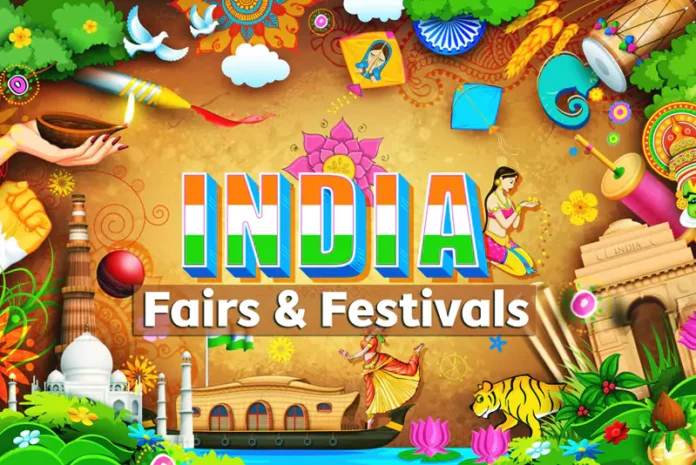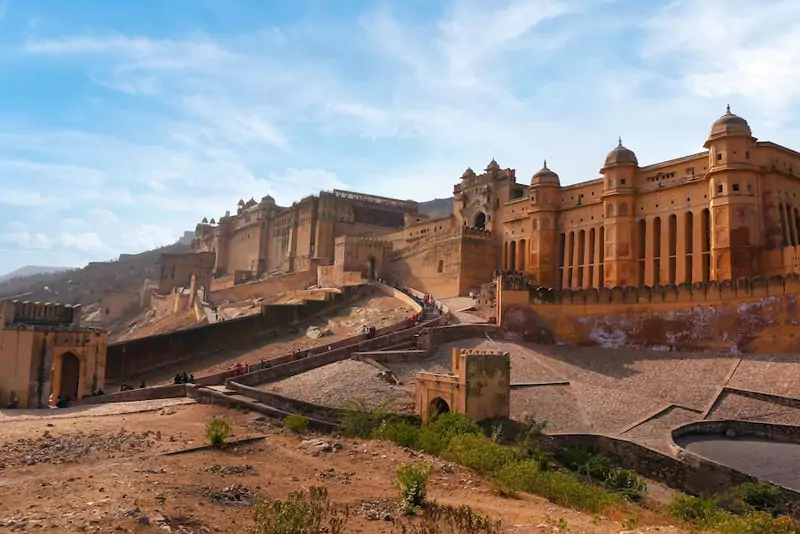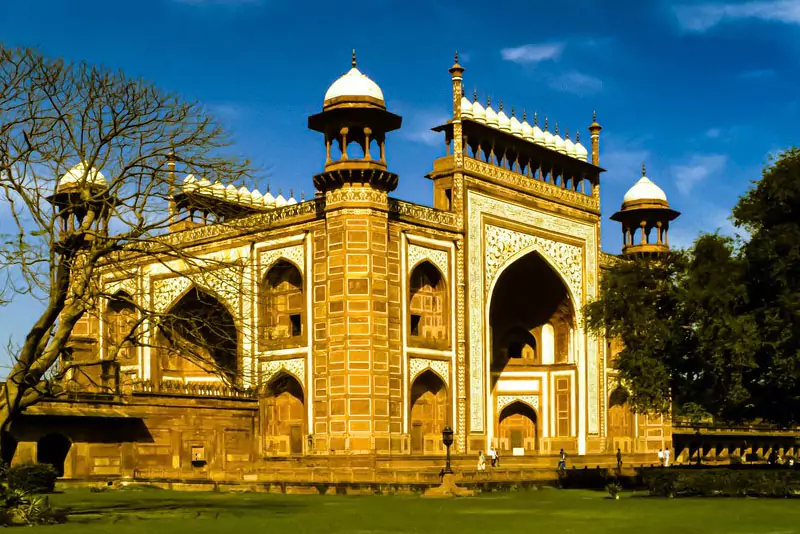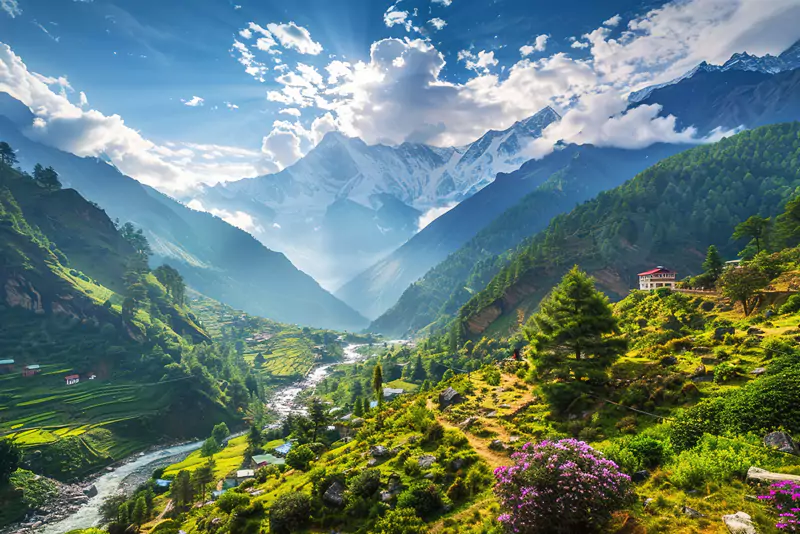India is a land of vibrant festivals and rich traditions—celebrated in every town and village with unmatched spirit. These events aren’t just joyful gatherings; they’re deeply rooted in religion, history, seasons, and local customs, offering a true reflection of India’s cultural soul.
From Holi, Diwali, Eid, and Christmas to regional highlights like Durga Puja in West Bengal, Ganesh Chaturthi in Maharashtra, Pongal in Tamil Nadu, Onam in Kerala, and Christmas in Goa—each festival showcases the diversity of the nation.
Don’t miss iconic fairs like the Pushkar Mela, Kumbh Mela, Goa Carnival, Surajkund Mela, and Snake Boat Races, which combine tradition with spectacle.
Bursting with color, music, dance, rituals, food, and community spirit, India’s fairs and festivals are a must for travelers seeking to experience the country’s true essence. Wherever you go, a celebration is never far away.-
1. Diwali – The Festival of Lights
Diwali, one of India’s most celebrated and vibrant festivals, marks the triumph of light over darkness and good over evil. Celebrated 20 days after Dussehra, it usually falls in October or November, welcoming the onset of winter and symbolizing new beginnings. The festival commemorates the return of Lord Rama and Sita to Ayodhya after defeating Ravana, and is also dedicated to Goddess Lakshmi, the deity of wealth and prosperity.

Homes across India are cleaned, renovated, and beautifully decorated with rangoli, candles, and earthen lamps (diyas) to welcome the goddess. Families worship Lakshmi at midnight, light fireworks, exchange sweets, gifts, and enjoy festive meals.
While Diwali is grandly celebrated throughout India, Jaipur stands out as a top destination. The city dazzles with elaborate light displays, decorated markets, and festive competitions—making it a must-visit for travelers looking to experience Diwali at its brightest.
2. Holi – The Festival of Colours
Holi, known as the Festival of Colours, is one of the most joyful and vibrant festivals in India, celebrated on the full moon day in the Hindu month of Phalgun (February–March). The festivities begin on the eve of Holi with a bonfire called Holika Dahan, symbolizing the victory of good over evil—rooted in the legend of Prahlad and the demoness Holika.
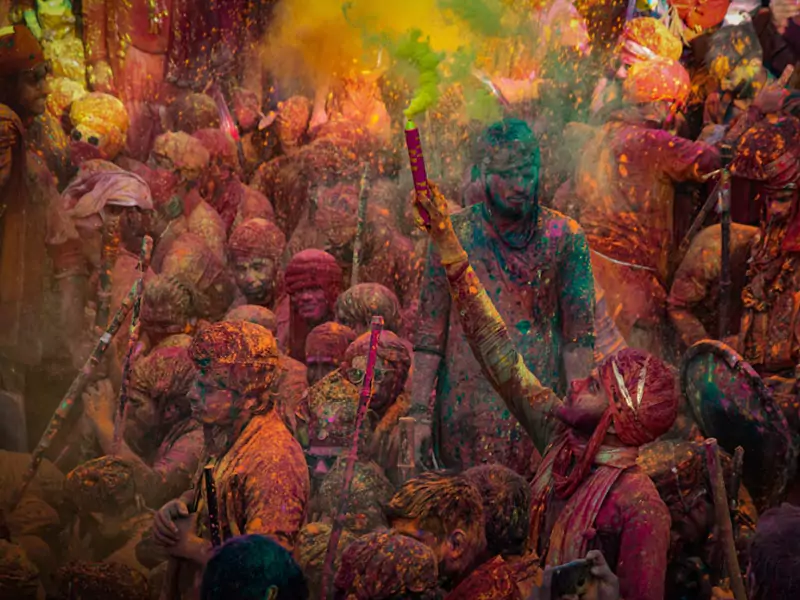
The next day, people throw colored powders (gulal) and splash colored water on each other, sing, dance, and enjoy festive sweets and drinks like bhang, creating an atmosphere of fun and unity.
Best Place to Experience Holi
Uttar Pradesh, especially Mathura, Vrindavan, and Barsana, offers the most authentic and lively Holi experience. In Braj, the birthplace of Lord Krishna, Holi celebrations begin a week early with traditional rituals like Lathmar Holi, where women playfully hit men with sticks—recreating ancient legends in a spirited and colorful manner.
3. Dussehra – The Triumph of Good Over Evil
Dussehra, also known as Vijaya Dashami, marks the victory of Lord Rama over the demon king Ravana, symbolizing the triumph of good over evil. It is celebrated on the 10th day of the Hindu month of Ashvin (September–October), following the nine-day festival of Navratri.

Across India, Dussehra is observed with great enthusiasm. In many regions, especially North India, the story of Rama is reenacted through Ramlila performances, culminating in the burning of giant effigies of Ravana, his son Meghnadh, and brother Kumbhakarna on the final day.
In West Bengal and other eastern states, the festival coincides with Durga Puja, celebrating Goddess Durga’s victory over the demon Mahishasura.
Dussehra also holds cultural significance as a day dedicated to Saraswati, the goddess of wisdom and learning, and it sets the stage for Diwali, which follows 20 days later.
4. Raksha Bandhan: A Festival of Sibling Bond
Celebrated on the full moon day of the Hindu month of Sravana (July–August), Raksha Bandhan is a heartwarming festival that celebrates the bond between brothers and sisters. On this day, sisters tie a decorative thread called a Rakhi on their brothers’ wrists, praying for their well-being and long life. In return, brothers give gifts and vow to protect their sisters.

Rooted in ancient Vedic traditions, the festival symbolizes love, protection, and familial ties. Historically, Rakhis were also tied to trusted allies for protection, showing the festival’s deeper social meaning.
Travel Tip: While not a large public celebration, travelers visiting India during Raksha Bandhan can witness colorful markets selling Rakhis, sweets, and festive clothing—especially in northern and western India. It’s a great time to observe local customs and the warmth of Indian family traditions.
5. Pongal – Tamil Nadu’s Vibrant Harvest Festival
Pongal is Tamil Nadu’s most important harvest festival, celebrated annually on January 15 to honor the Sun God and nature’s bounty. The word Pongal means “boiling over,” symbolizing abundance, and also refers to a sweet rice dish made from freshly harvested rice, jaggery, and milk.
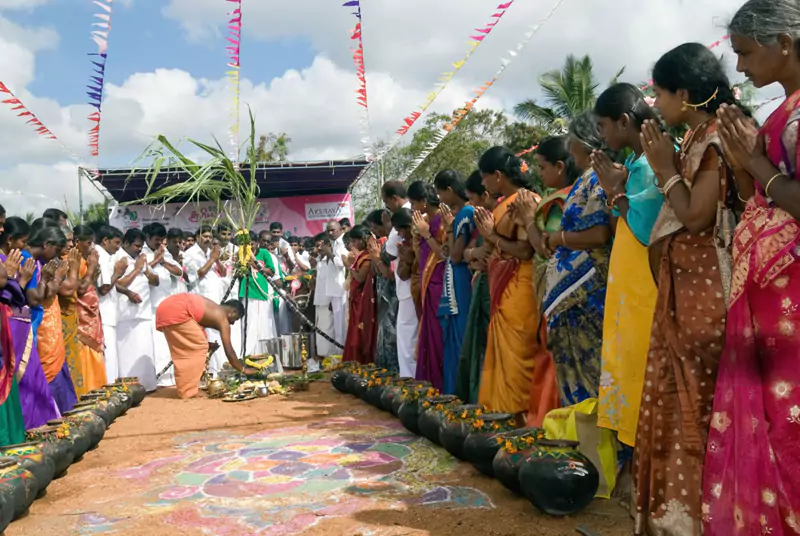
This four-day festival is full of color, rituals, and celebration:
- Bhogi Pongal – Day for family, cleaning homes, and discarding old belongings.
- Surya Pongal – Dedicated to Sun God; traditional cooking of Pongal dish in decorated courtyards.
- Mattu Pongal – Cattle are honored, decorated, and worshipped; in some regions, Jallikattu, the traditional bull-taming sport, is held.
- Kaanum Pongal – A day for socializing, outings, and celebrating with nature and birds.
Homes are beautifully decorated with Rangoli (kolam), flowers, and colorful garlands. Doors are adorned with turmeric, sandalwood paste, and mango leaves.
While Pongal is specific to Tamil Nadu, similar harvest festivals are celebrated across India:
- Makar Sankranti (pan-India)
- Lohri (Punjab and North India)
- Magh Bihu (Assam)
- Paush Parbon (West Bengal), where pilgrims bathe at Gangasagar, where the Ganga meets the sea.
Travel Tip: Tamil Nadu is the best place to experience the authentic Pongal festivities, especially in rural areas or cities like Madurai, Thanjavur, and Chennai, where traditional customs come alive with food, music, and cultural displays.
6. Eid-ul-Fitr – The Festival of Breaking the Fast
Eid-ul-Fitr, also known as Ramzan Id, marks the end of Ramzan (Ramadan)—a holy month of fasting, prayer, and reflection for Muslims. The celebration begins with the sighting of the new moon, signaling the end of the fasting period.
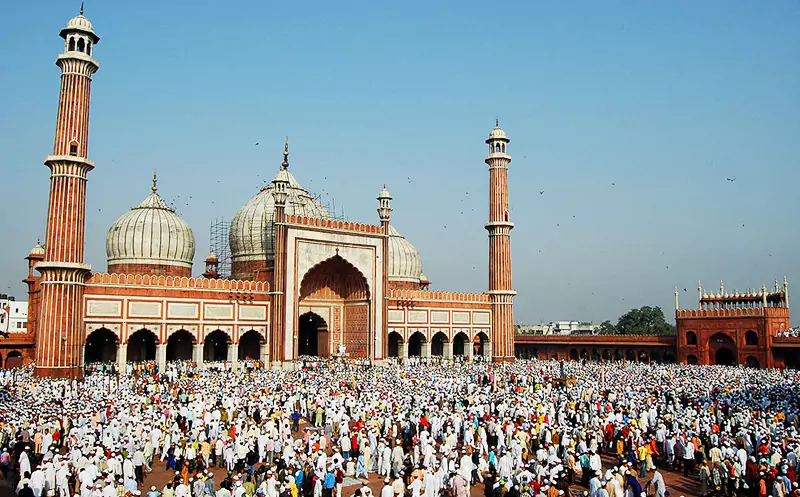
On Eid morning, Muslims gather at mosques and open grounds (Idgahs) for special prayers, dressed in their finest clothes. The day is filled with festive meals, sweets like sheer kurma, and visiting friends and family. It’s a time of joy, generosity, and community bonding.
Travel Tip: Eid is a vibrant time to visit Muslim-majority areas across India, such as Old Delhi, Hyderabad, Lucknow, or Bhopal, where you can experience the spirit of togetherness, bustling markets, and delicious festive food.
7. Bakrid – The Festival of Sacrifice
Bakrid, also known as Eid al-Adha, is one of the most important Islamic festivals, celebrated with deep devotion across India—especially in places like Andhra Pradesh, Hyderabad, Lucknow, and Kolkata.
The festival commemorates the willingness of Prophet Ibrahim to sacrifice his son as an act of obedience to God. To honor this, families offer prayers at mosques and sacrifice a goat or sheep, sharing the meat among family, friends, and the needy.
Travel Tip: If you’re visiting during Bakrid, you can witness the spirit of generosity and community, experience traditional festive dishes like biryani and kebabs, and observe vibrant prayer gatherings, especially in cities with a strong Muslim heritage.
8. Onam: Kerala’s Grand Harvest Festival
Onam is Kerala’s most important festival, celebrated in honor of the legendary King Mahabali and to mark the beginning of the harvest season. The ten-day celebration fills the state with vibrant traditions—homes are decorated with intricate flower carpets (Pookalam), traditional songs are sung, and a lavish vegetarian feast known as Onasadya is enjoyed on banana leaves.
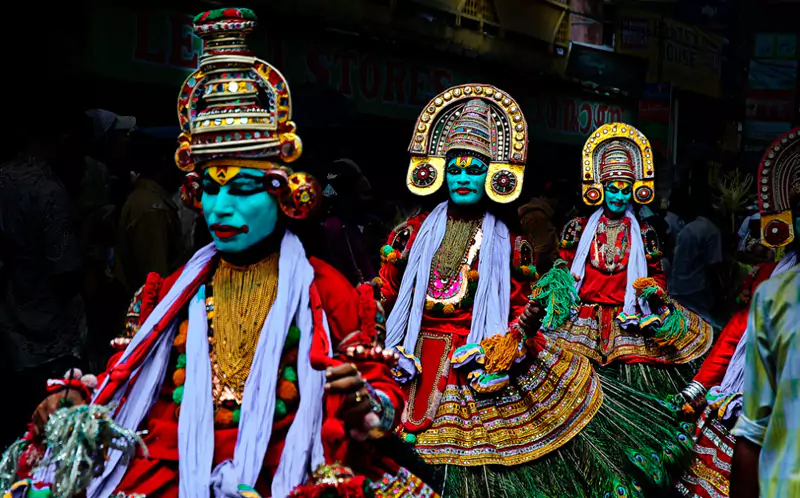
Travelers can witness colorful cultural performances, temple rituals, and one of the biggest highlights—the thrilling snake boat races held in scenic backwaters at places like Champakulam, Aranmula, and Kottayam. Onam offers a deep dive into Kerala’s culture, hospitality, and festive spirit—making it an unmissable experience for visitors.
9. Janmashtami: Celebrating the Birth of Lord Krishna
Janmashtami marks the birth of Lord Krishna and is one of the most joyful and spiritually uplifting festivals in North India. Celebrated on the 8th day of the dark fortnight (Ashtami) in the Hindu month of Bhadon (August–September), the event brings temples and streets alive with devotion, music, and color.
Travelers can experience Raslila performances—dramatic reenactments of Krishna’s playful life and his love for Radha. As night falls, devotees gather to sing bhajans (devotional songs) leading up to midnight, the divine moment of Krishna’s birth. At that hour, temples come alive with arti (rituals), chants, and the offering of prasad, while flower petals are showered on Krishna idols.
Visiting cities like Mathura or Vrindavan during Janmashtami offers an unforgettable cultural and spiritual experience—filled with joy, tradition, and devotion.
10. Muharram: A Solemn Remembrance in Kerala
Muharram marks the beginning of the Islamic Hijri New Year and holds deep spiritual significance, especially for Shia Muslims. The 10th day, known as Ashura, is observed to commemorate the martyrdom of Imam Hussain, the grandson of Prophet Muhammad, in the historic Battle of Karbala.
In parts of Kerala, especially in Muslim communities, travelers can witness processions featuring Taziyas—beautifully crafted replicas of Imam Hussain’s tomb made from bamboo and paper, often decorated with shining mica. These are carried through the streets in a solemn tribute.
The atmosphere is filled with rhythmic drumbeats and the emotional chants of mourners as they express grief through traditional rituals like chest-beating. Fasting is also a key part of the observance, symbolizing sacrifice and devotion.
While not a festive celebration, Muharram offers travelers a respectful and moving glimpse into Islamic history, faith, and community traditions in India.
11. Navratri: Celebrating the Divine Feminine Power
Navratri, meaning “nine nights,” is a vibrant Hindu festival celebrated across India to honor Goddess Durga, the divine embodiment of power (Shakti). It begins on the first day of the Hindu month of Ashvin (usually September–October) and lasts for nine days, each dedicated to different forms of the goddess—such as Durga, Lakshmi, Saraswati, and Kali.
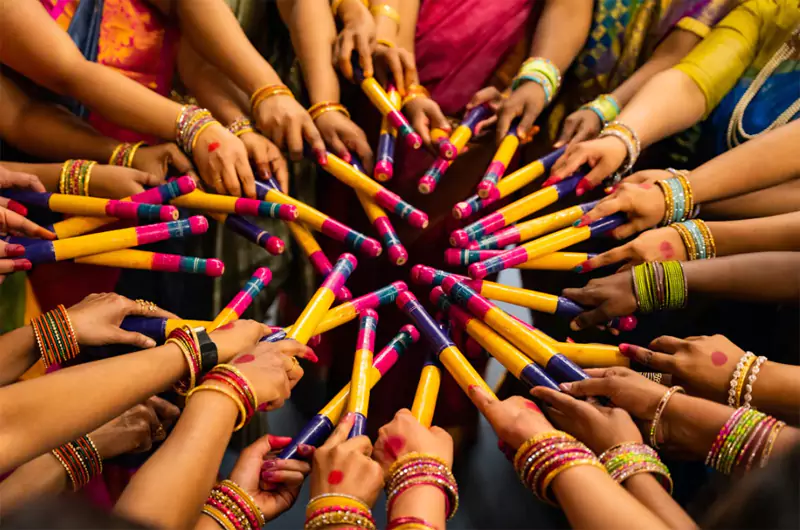
According to legend, Goddess Durga fought the powerful demon Mahishasura for nine days, finally defeating him on the tenth day, symbolizing the triumph of good over evil.
Travelers can experience this celebration through elaborate rituals, colorful dances like Garba and Dandiya in Gujarat, and grand Durga Puja pandals in West Bengal, where beautifully decorated idols are worshipped with music, food, and cultural performances. The goddess is often depicted riding a lion and holding weapons, representing protection, justice, and strength.
Whether you’re watching a fiery performance of traditional dance, exploring local fairs, or witnessing devotional ceremonies, Navratri is a powerful and spiritual celebration not to be missed.
12. Christmas in India: A Joyful Blend of Faith and Festivity
Christmas in India is a vibrant celebration filled with lights, joy, and togetherness. Cities across the country—especially in Goa, Kerala, Mumbai, Kolkata, and parts of Northeast India—come alive with festive decorations, illuminated churches, and bustling markets offering special treats and gifts.
Travelers can enjoy midnight masses, carol singing, and community feasts. Streets and shops are adorned with stars, fairy lights, and Christmas trees, creating a warm, welcoming atmosphere. Locals and tourists alike join in the cheer with get-togethers, gift exchanges, and parties that often continue into New Year’s celebrations.
Whether you’re strolling through a Christmas market, savoring plum cake, or attending a mass in a centuries-old church, Christmas in India offers a unique cultural twist to this global holiday.
13. Ganesh Chaturthi: A Grand Celebration of India’s Beloved Elephant God
Ganesh Chaturthi is a vibrant 10-day Hindu festival celebrating Lord Ganesha, the remover of obstacles and bringer of good fortune. Celebrated with great devotion and energy, especially in Mumbai, Pune, and across Maharashtra, this festival offers travelers a deep cultural experience.
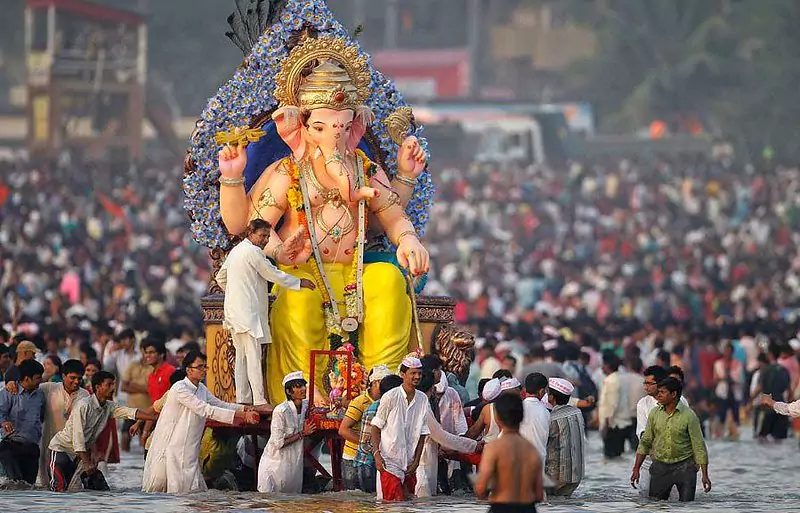
During the celebration, beautifully crafted idols of Ganesha are installed in homes and public pandals (temporary shrines). Visitors can explore the city’s decorated streets, witness devotional music and dance performances, and sample delicious sweets like modaks, Ganesha’s favorite treat.
The festival ends with grand processions, where idols are carried to rivers or the sea and immersed, symbolizing Ganesha’s return to the heavens. The sight of thousands gathered along Mumbai’s Girgaum Chowpatty or Juhu Beach, chanting and singing during the final immersion is truly unforgettable.
A must-see for travelers, Ganesh Chaturthi is a spectacular blend of spirituality, art, and community spirit.
14. Maha Shivratri: A Night of Divine Energy and Devotion
Maha Shivratri, meaning “The Great Night of Shiva,” is a sacred Hindu festival celebrated across India. It marks the legendary night when Lord Shiva performed the cosmic dance of Tandav. Devotees observe fasts, chant prayers, and visit temples, staying awake through the night in spiritual reflection.
For travelers, this is an ideal time to witness vibrant rituals and cultural devotion. Major celebrations take place at famous Shaivite temples, including:
- Kashi Vishwanath in Varanasi (Uttar Pradesh)
- Sri Kalahasteeswara Temple in Andhra Pradesh
- Chidambaram Temple in Tamil Nadu
Expect chanting, temple processions, and a spiritually charged atmosphere—an unforgettable cultural experience.
15. Basant Panchami: Welcoming Spring with Wisdom and Color
Celebrated in January or February, Basant Panchami marks the arrival of spring and is dedicated to Goddess Saraswati, the deity of wisdom, learning, and the arts. It is a special day for students and scholars who worship the goddess for knowledge and enlightenment.
The festival is widely celebrated across Bihar, West Bengal, Assam, Odisha, Punjab, and Haryana. In Rajasthan, devotees offer jasmine garlands, while Punjab hosts community feasts (langars).
A signature of the festival is the vibrant yellow color—symbolizing energy and prosperity. People wear yellow clothing and prepare traditional yellow dishes like saffron rice and kadhi.
Date in 2025: Sunday, 2nd February
Best Places to Experience: West Bengal, Punjab, Assam, Bihar, and Odisha
Things to Do: Attend Saraswati Puja, witness traditional music and dance, and enjoy local festive foods
16. Makar Sankranti: A Festival of Sun, Kites, and New Beginnings
Makar Sankranti, celebrated on 14th January 2025, marks the end of winter and the beginning of spring, symbolizing a fresh start and the beginning of the agricultural cycle for farmers. Unlike most Hindu festivals that follow the lunar calendar, Makar Sankranti follows the solar calendar, so the date remains fixed each year.
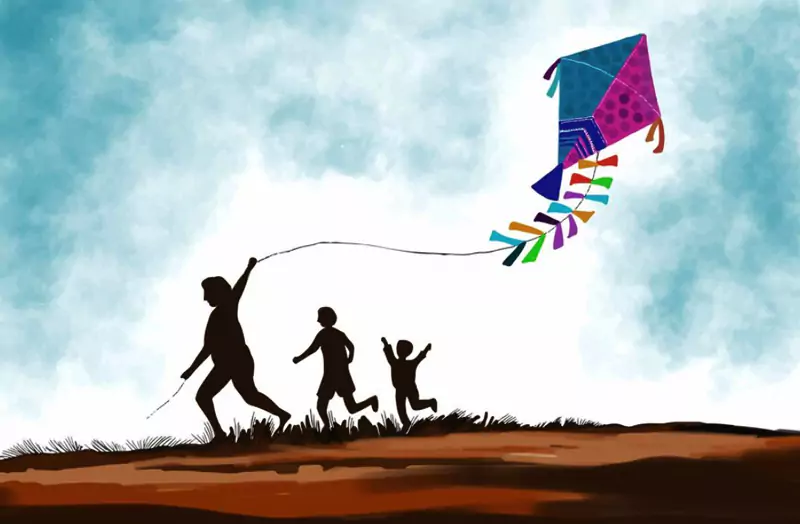
Celebrated widely across North India and by Sikh communities, the festival is known for its vibrant kite flying, special prayers, and traditional foods like Bajre ki khichdi (a savory millet dish) and til ladoos (sweet sesame treats). In Gujarat, it’s known as Uttarayan, and the skies are filled with colorful kites.
Date: Tuesday, 14th January 2025
Where to Celebrate: Best experienced in Punjab, Delhi, Uttar Pradesh, and Gujarat (for kite festivals)
Things to Do: Join local kite-flying events, visit temples, enjoy festive foods, and soak in the cultural energy
Travelers can witness a joyful mix of tradition and celebration as communities come together to welcome longer, sunnier days.
17. Baisakhi: Punjab’s Vibrant Harvest & Cultural Celebration
Celebrated with great enthusiasm on 13th April 2025 (Sunday), Baisakhi marks the harvest festival of the rabi crops and holds deep religious significance for the Sikh community. It commemorates the founding of the Khalsa Panth by Guru Gobind Singh in 1699, making it a spiritual as well as seasonal celebration.
The best place to experience Baisakhi is in Punjab, where the energy is unmatched. Folk dances like Bhangra and Giddha, colorful fairs, and festive feasts fill the atmosphere with joy. Gurudwaras are beautifully decorated, and special prayers and langars (community meals) are held throughout the region.
Date: Sunday, 13th April 2025
Where to Celebrate: Best experienced in Punjab, especially in cities like Amritsar and Anandpur Sahib
Things to Do: Visit Gurudwaras, enjoy traditional Punjabi food, watch folk dance performances, and join local processions
Travelers can immerse themselves in the rich culture, warmth, and hospitality of Punjab during this vibrant and meaningful festival.
18. Easter in India: A Joyful Springtime Celebration
Easter, celebrated on Sunday, 20th April 2025, marks the resurrection of Lord Jesus Christ and is observed with both religious devotion and festive cheer across India. Taking place during spring, the festival brings communities together with colourful decorations, folk songs and dances, and special treats like simmel and plum cakes, Easter eggs, and chocolates. Streets are often lit with bright lanterns, creating a vibrant and welcoming atmosphere.
The best places to experience Easter in India include Goa, Pondicherry, and Kerala, where churches hold midnight masses, and local traditions add a unique touch to the celebration.
Where to Celebrate: Goa, Pondicherry, Kerala
Things to Do: Attend church prayers, enjoy festive music, try traditional Easter treats, and explore decorated streets
Whether you’re religious or just looking to soak in the cultural experience, Easter in India offers a beautiful blend of spirituality and celebration.
20. Bihu Festival in Assam: A Joyous Celebration of Harvest and Culture
Bihu is the most celebrated festival in Assam and holds a special place among festivals in Northeast India. Marking the traditional Assamese New Year, Bihu is a vibrant harvest festival that brings together communities with music, dance, and feasting. In 2025, Bihu will be celebrated from 14th April to 20th April (Monday to Sunday).
During this festive week, young men and women dress in traditional Assamese attire and perform the energetic and graceful Bihu dance in village fields and courtyards. Community feasts are organized, showcasing authentic Assamese cuisine like til pitha, coconut ladoos, ghila pitha, and fish pitika, adding to the celebratory spirit.
Where: Primarily in Assam, and among Assamese communities worldwide
What to Do: Join traditional celebrations, watch or participate in Bihu dances, and savour local dishes
The Bihu festival is a must-experience cultural event for travellers, offering a perfect blend of warm hospitality, colorful traditions, and regional flavors in the heart of Assam.
21. Gurpurab: A Sacred Sikh Celebration of Faith and Service
Gurpurab, one of the most significant festivals in Sikhism, commemorates the birth anniversaries of the Sikh Gurus, especially Guru Nanak Dev Ji. In 2025, it will be observed on Wednesday, 5th November. The celebrations are marked by soulful hymn chanting (Bhajan-Kirtan), Gurbani recitations, and processions. Gurudwaras host special prayer assemblies, and Langars (community meals) are served to all, regardless of background. Devotees also light up their homes with candles and lamps, and Karah Prasad is distributed.
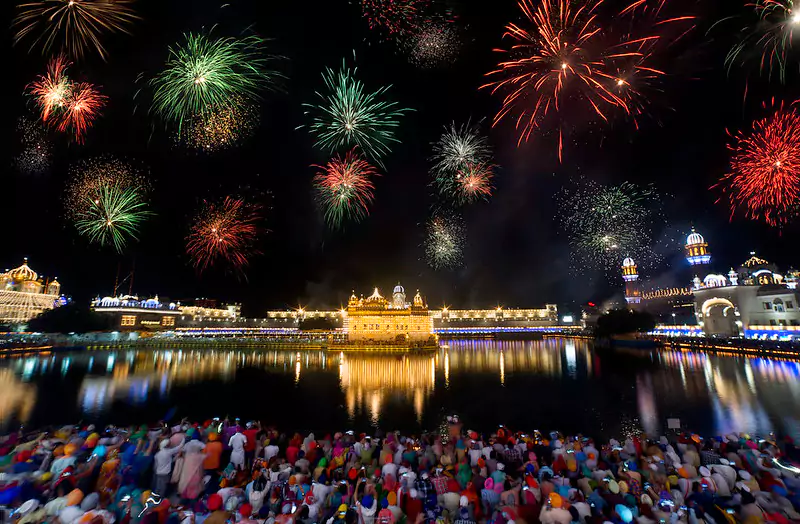
Where: Most vibrant in Punjab, but celebrated by Sikh communities worldwide
Things to Do: Visit a Gurudwara, participate in sewa (voluntary service), share Langar, and engage in charity
Gurpurab offers travellers a chance to witness the spirit of equality, devotion, and service in Sikh tradition.
22. Durga Puja Festival: Where Spirituality Meets Spectacle
Durga Puja, one of the most important Hindu festivals in India, is celebrated with immense grandeur, especially by the Bengali community. In 2025, the festival will be held from 28th September to 2nd October. The celebration spans ten days of worship, fasting, and feasting, with the last five days being the most vibrant. Elaborate pandals (temporary structures) house stunning idols of Goddess Durga, and the atmosphere comes alive with cultural performances, traditional music, and festive food. People dress in ethnic attire and go pandal-hopping, immersing themselves in the devotional and artistic spirit of the event.
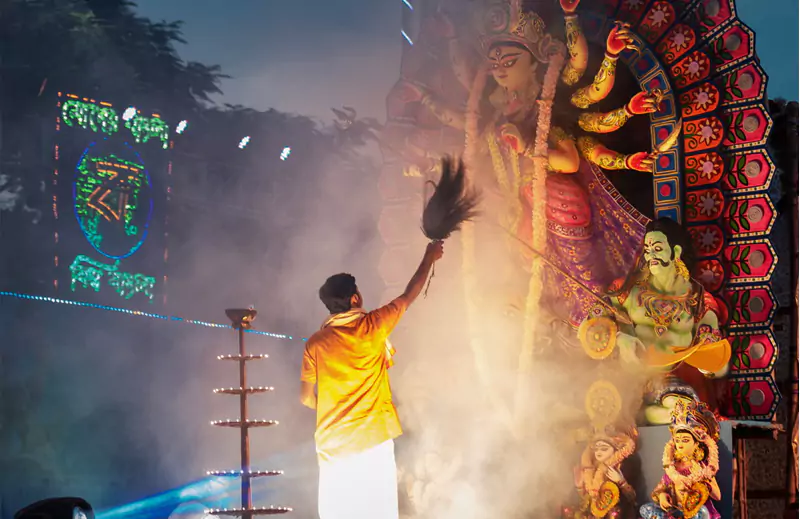
Where: Best experienced in Kolkata, though major Indian cities also celebrate it grandly
Things to Do: Explore themed pandals, enjoy local delicacies, and witness the cultural vibrancy of Durga Puja
23. Mahavir Jayanti: Celebrating the Birth of Lord Mahavir
Mahavir Jayanti, celebrated on Thursday, 10th April 2025, marks the birth anniversary of Lord Mahavir, the 24th Tirthankara of Jainism. Observed mainly in Gujarat and Rajasthan, the day is marked by prayers, fasting, and a grand Rath Yatra (procession) of Lord Mahavir’s idol. Temples hold special rituals including Mahabhishek, where the idol is ceremonially bathed with milk and flowers. It’s an ideal time for travelers to witness Jain spiritual traditions and participate in peaceful temple celebrations.
24. Ugadi: Welcoming the New Year in South India
Ugadi marks the traditional New Year for the people of Karnataka, Andhra Pradesh, and Telangana, and is one of the most vibrant regional festivals in South India. Celebrated on the first day of the Chaitra month in the Hindu lunisolar calendar, it’s a time for new beginnings and gratitude for the harvest. Locals decorate their homes with colorful rangolis and mango leaf toranas, wear new clothes, exchange gifts, and enjoy festive foods like Pulihora, Ugadi Pachadi, and Bobbatlu, which blend flavors of sweet, sour, and bitter symbolizing the essence of life. For travelers, it’s a unique opportunity to experience authentic South Indian culture, cuisine, and community spirit. In 2025, Ugadi falls on Sunday, 30th March—a perfect day to join the celebrations in cities like Hyderabad, Bengaluru, or Vijayawada.
Fairs of India: A Cultural Tapestry
1. Kumbh Mela: The World’s Largest Spiritual Gathering
The Kumbh Mela is one of India’s most sacred and awe-inspiring religious festivals, drawing millions of pilgrims, sadhus (holy men), and travelers from around the globe. Rooted in the ancient myth of the gods and demons battling over the nectar of immortality, the festival is held at four rotating locations: Haridwar, Prayagraj (Allahabad), Nashik, and Ujjain.

The main ritual is the holy dip in sacred rivers—especially at confluence points—believed to cleanse sins and grant spiritual liberation. One of the most iconic scenes unfolds at Har Ki Pauri in Haridwar and Sangam in Prayagraj, where pilgrims gather at dawn for mass river bathing.
The Mela is famous for its vibrant and surreal atmosphere: ash-covered sadhus, spiritual processions, elephant parades, drumbeats, and devotional chants fill the air. For travelers, it offers a rare and immersive glimpse into India’s living spirituality and cultural intensity.
Tip: Check the calendar as the Kumbh Mela occurs every 12 years at each location, with the Ardh Kumbh (every 6 years) and Maha Kumbh (every 144 years) at Prayagraj being particularly significant.
2. Pushkar Fair: A Spectacle of Culture and Camels
Held on the full moon day of the Hindu month of Kartik (October–November), the Pushkar Fair is one of India’s most iconic festivals. Taking place in the holy town of Pushkar, Rajasthan, near the sacred Pushkar Lake, this vibrant event combines religious devotion with cultural celebration.

Thousands of pilgrims gather to take a holy dip in the lake, believed to have been created by Lord Brahma. The fair is also home to the world’s largest camel market, where camels are traded, raced, and dressed up for beauty contests. The atmosphere comes alive with folk music, colorful attire, puppet shows, local handicrafts, and traditional performances—making it a must-visit for travelers seeking a deep dive into Rajasthan’s heritage.
Dates for Pushkar Fair 2025:
The fair will be held from October 28 to November 5, 2025, with Kartik Purnima falling on November 5, 2025.
The fair usually runs for 7 to 9 days, culminating on the full moon, which is considered the most auspicious day for taking a dip in the sacred Pushkar Lake.
3. Surajkund Crafts Fair, Haryana
Held every February in Surajkund, Haryana, this vibrant fair celebrates India’s rich heritage, showcasing handicrafts, handlooms, folk art, and traditional performances from across the country and the world.
With participation from international artists and countries, the fair features:
- Colorful handmade crafts & textiles
- Live folk music and dance
- A global food court offering multi-ethnic cuisines
- A focus on reviving fading traditional skills
Surajkund International Crafts Mela 2025
The Surajkund International Crafts Mela is held annually every February in Surajkund, Faridabad, Haryana, India. The 38th edition of this globally renowned cultural fair will take place from February 7 to 23, 2025.
It’s a must-visit cultural festival that blends art, food, and tradition in one unforgettable experience.
4. Sonepur Cattle Fair, Bihar
Dates: Held every November near Patna, Bihar, on the banks of the Ganga River.
The Sonepur Cattle Fair is Asia’s largest and oldest livestock fair, dating back to the Mauryan Empire—over a thousand years ago. Originally a major trading hub for animals, today it’s a vibrant cultural spectacle attracting visitors from across the globe.
Highlights:
- The iconic Hathi Bazaar (Elephant Market), where elephants are paraded and displayed.
- Trade of various animals like horses, buffaloes, goats, birds, and donkeys.
- A mix of cultural performances, local food, and rural crafts, making it more of a cultural festival than just a cattle market.
A visit to the Sonepur Fair offers a glimpse into India’s ancient trade traditions, along with a unique cultural experience in rural Bihar.
5. Goa Carnival: A Colorful Celebration of Culture and Joy
The Goa Carnival is a lively and colorful festival held every February, about 40 days before Lent. Dating back to the 18th century, it reflects Goa’s rich Portuguese heritage and brings the entire state to life with vibrant celebrations. The carnival kicks off in Panjim and makes its way through other cities like Mapusa, Margao, and Vasco da Gama, filling the streets with energy and joy. For three days, locals and tourists enjoy grand parades, live music, dancing, and people dressed in elaborate costumes and masks, creating an atmosphere similar to Latin-style carnivals. The festivities are accompanied by delicious Goan cuisine, especially exotic seafood, and the coastal vibe is enhanced with bonfire nights, beach parties, and live entertainment near the beaches. It’s one of Goa’s most awaited events, offering a unique blend of culture, fun, and food.
6. Hemis Festival in Ladakh: A Spiritual and Cultural Spectacle
Celebrated in the breathtaking region of Ladakh, the Hemis Festival is one of India’s most fascinating and important religious festivals, attracting both locals and international travellers. Held at the stunning Hemis Monastery, the two-day celebration honours the birth anniversary of Guru Padmasambhava, the revered founder of Tibetan Tantric Buddhism. In 2025, the festival will take place on 5th and 6th July (Saturday and Sunday).
One of the main highlights is the Cham dance, a sacred masked dance performed by monks dressed in elaborate brocade robes, set to the rhythm of traditional instruments like cymbals, drums, and long trumpets. The dramatic performances are deeply spiritual and rich in symbolism, offering visitors a rare cultural insight.
Where: Hemis Monastery, Ladakh, Jammu & Kashmir
What to Do: Witness the mystical Cham dance, explore the monastery, and soak in the festive mountain atmosphere
The Hemis Festival is a once-in-a-lifetime experience combining spirituality, history, and high-altitude beauty—perfect for travellers looking to explore the deeper cultural layers of India.
7. Hampi Festival (Vijaya Utsav)
Location: Hampi, Karnataka
Time: January / February
The Hampi Festival, also known as Vijaya Utsav, is a vibrant cultural celebration that brings the ancient city of Hampi to life. Set against the breathtaking backdrop of UNESCO-listed ruins, the festival features classical dance performances, live music concerts, puppet shows, and grand processions that showcase Karnataka’s rich heritage.
Held every January or February, this colorful event draws thousands of visitors from around the world, making it one of the most iconic cultural festivals in India. It’s a perfect opportunity to immerse yourself in history, art, and tradition, all in one unforgettable setting.
8. Ambubachi Mela
Location: Kamakhya Temple, Guwahati, Assam
Time: June (Monsoon Season)
The Ambubachi Mela is a one-of-a-kind spiritual festival held every June at the Kamakhya Temple in Guwahati, Assam. It honors the annual menstruation of Goddess Kamakhya, symbolizing the fertility of the Earth and the power of the divine feminine.
During the festival, the temple remains closed for three days, believed to be the goddess’s time of rest. On the fourth day, the temple reopens with great reverence, and thousands of pilgrims, sadhus, and spiritual seekers gather to offer prayers and witness tantric rituals and sacred ceremonies.
With its deep symbolism and intense spiritual atmosphere, the Ambubachi Mela offers a powerful cultural experience for travelers interested in India’s mystical traditions and sacred festivals.
9. Shilpgram Fair
Location: Udaipur, Rajasthan
Time: December
Held every December in the scenic Shilpgram village near Udaipur, the Shilpgram Fair is a vibrant celebration of India’s rural arts, crafts, and culture. This colorful festival brings together talented artisans from across the country, offering a unique opportunity to explore handmade textiles, pottery, jewelry, and traditional crafts all in one place.
Beyond shopping, visitors can enjoy folk music, dance performances, and cultural showcases that reflect the rich heritage of India’s rural communities. The fair not only offers a memorable cultural experience but also supports the preservation of traditional art forms by giving local artisans a platform to share and sell their work.
If you’re in Udaipur in December, the Shilpgram Fair is a must-visit for craft lovers, culture enthusiasts, and curious travelers alike.
10. Poush Mela
Location: Shantiniketan, West Bengal
Time: December
The Poush Mela, held every December in Shantiniketan, is a beloved rural fair that celebrates the harvest season and the rich folk traditions of Bengal. Founded by Rabindranath Tagore’s family, this cultural event attracts artists, students, and travelers from all over India and beyond.
The fair is known for its soulful Baul music, folk dance performances, and a vibrant bazaar of handmade crafts, textiles, and local delicacies. Set against the artistic atmosphere of Visva-Bharati University, Poush Mela offers a perfect blend of culture, creativity, and community spirit.
It’s a must-visit for those seeking an authentic cultural experience in rural Bengal.
11. Nagaur Fair
Location: Nagaur, Rajasthan
Time: January / February
The Nagaur Fair is one of Rajasthan’s largest and most colorful livestock fairs, held annually in Nagaur between January and February. While it’s known for the trading of cattle, camels, and horses, the fair also offers a lively mix of cultural events and traditional sports.
Visitors can enjoy camel races, tug-of-war contests, folk music and dance performances, all set in a buzzing fairground atmosphere. With vibrant costumes, local cuisine, and handcrafted goods on display, the Nagaur Fair offers a true glimpse into rural Rajasthani life and culture.
12. Gangasagar Mela
Location: Sagar Island, West Bengal
Time: January (during Makar Sankranti)
The Gangasagar Mela, held every January on Sagar Island, is one of India’s most important spiritual gatherings. Pilgrims from across the country come to take a holy dip at the confluence of the Ganges River and the Bay of Bengal, believed to cleanse the soul and wash away sins.
Beyond the sacred bath, the mela features religious rituals, devotional music, and cultural performances, all set against the serene coastal backdrop. With its deep spiritual significance and peaceful setting, Gangasagar Mela offers a unique and meaningful experience for both pilgrims and curious travelers alike.






